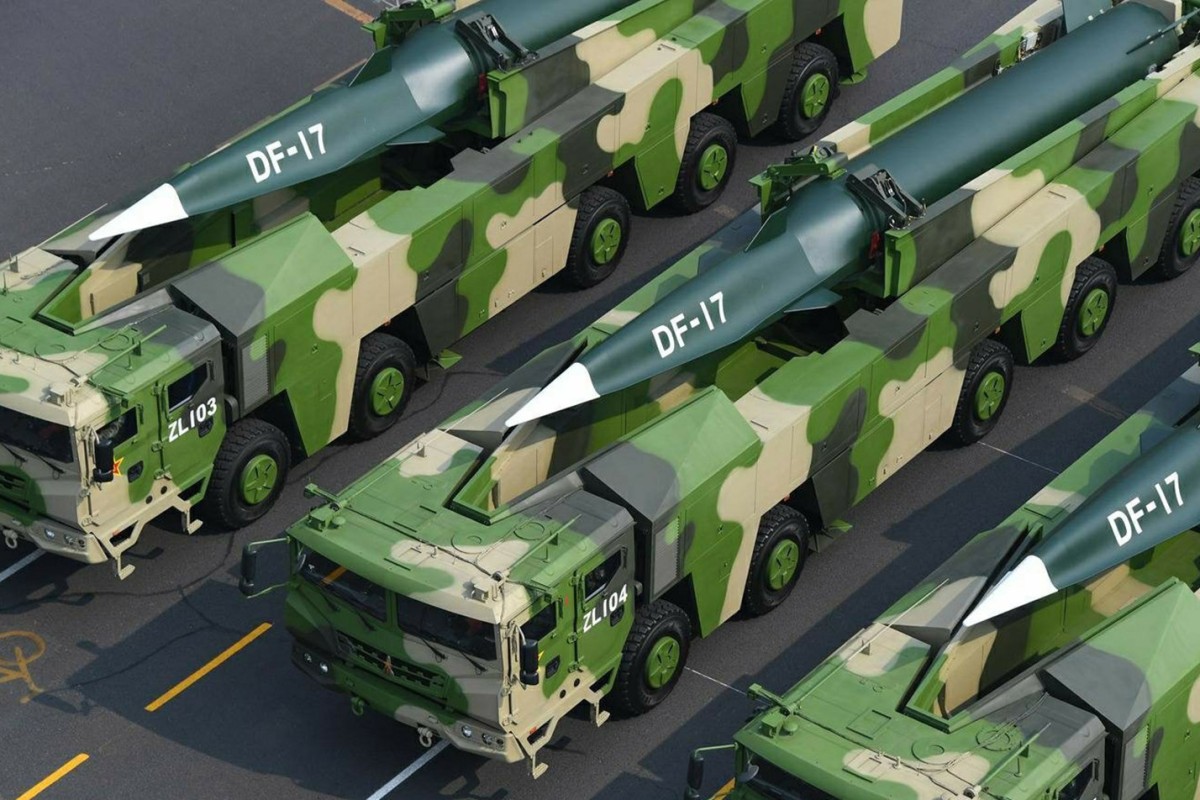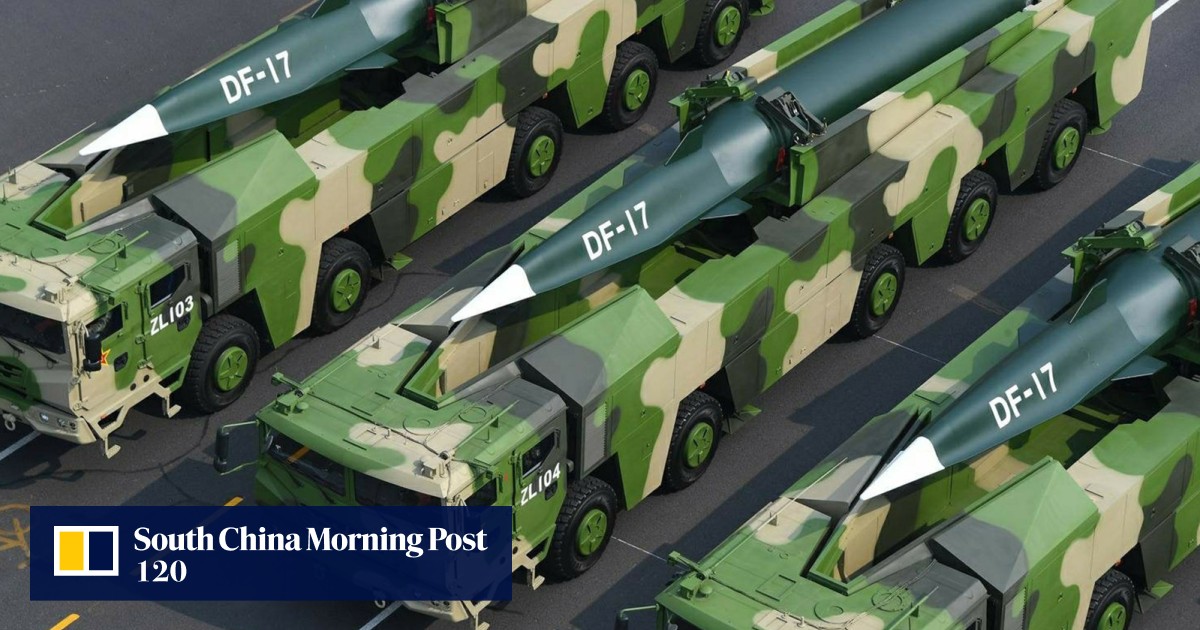beijingwalker
ELITE MEMBER

- Joined
- Nov 4, 2011
- Messages
- 65,191
- Reaction score
- -55
- Country
- Location
Fifth force: is China adding hypersonic ‘near-space command’ to its military for ‘precise and merciless’ attacks?
- Believed to be the first in the world, the new branch reports to high levels of the PLA, paper shows
- Researchers said the hotly contested zone at the edge of space could determine the outcome of future battles
Published: 11:00pm, 20 Nov, 2023

The DF-17 can be mounted on a hypersonic glide vehicle. Photo: Weibo
In what is believed to be a world first, China has established a near-space command equipped with a professional hypersonic weapons force that reports directly to the highest level of the military, according to a recently published paper.
The new force joins the People’s Liberation Army’s army, air force, navy and rocket branches.
“The near-space combat force is in the process of rapid development. The establishment of relevant units is not yet mature, and combat operations have not been standardised. The understanding of near-space combat command needs to be deepened,” said the researchers from the National University of Defence Technology.
“It is necessary to adjust the hierarchy of command and control powers, selection of command methods, implementation of executive orders and support for command communication.”
When the force was established remains unclear and the South China Morning Post cannot independently verify these claims.
In a paper submitted to the 11th China Command and Control Conference in October and now available publicly on major Chinese academic databases, the team said near-space had become a hotly contested zone that could “determine the outcome of future battles”.
The researchers said the command would be equipped to carry out “merciless” attacks on critical targets, as well as high-altitude surveillance around the globe through automated drones and spy balloons.
“The near-space force operates in a special battlefield. Actions carried out in sensitive areas or over the territory of other countries may trigger political or diplomatic reactions,” they said.
This made it necessary “to shift the decision-making power upwards”, right down to daily combat readiness operations for the near-space force’s stratospheric airships, long-endurance unmanned aerial vehicles and other platforms.
“The highest military command can approve the scale of use, activity areas and method of use to avoid causing political and diplomatic nuisance,” the paper said.
The researchers said China had realised that hypersonic weapons were a double-edged sword – designed to hit a target anywhere on Earth with unstoppable speed and manoeuvring capabilities, but posing challenges in politics and international relations.
In addition to its hypersonic weapons, the near-space force also operated “a large number” of spy balloons, solar-powered drones and other supporting equipment, the paper said.
These automated platforms operated at low speeds but could stay at high altitudes for weeks or even months, providing critical services such as surveillance and communication relay, the research team said.
But the force’s most important duty will be to help China win in the event of a war. The researchers said hypersonic weapons would be trained on heavily protected critical military assets – such as giant antennas and major communication hubs – in an adversary’s heartland.
According to the researchers, the loss of critical infrastructure in the early stages of a conflict would break down an enemy’s war machine and severely affect its ability and willingness to fight.
“This could change the pace of battles and bring a major impact to how a war would end,” they said, adding that the near-space force could also target civilian infrastructure – such as SpaceX’s launch pads in the US.
“Hypersonic weapons can attack rocket launch sites, [destroying] the enemy’s ability to fire anti-satellite missiles on our civilian satellite networks,” the researchers said. “These attacks must be precise, overwhelming and merciless.”
Near-space starts at an altitude of about 20km (12 miles) and reaches the lower boundary of space at 100km from Earth. The air is too thin to support planes and too thick for orbiting satellites, and is mostly avoided by military operators.
Hypersonic weapons can fly in near-space at more than five times the speed of sound and cheat air defence systems with their unpredictable manoeuvres. Some are also equipped with air-breathing engines that use oxygen in the atmosphere to boost their range.
China unveiled the world’s first in-service hypersonic weapons at its National Day parade in 2019. Since then, other countries including Russia, North Korea and Iran have deployed similar technology, while in the US a number of prototypes remain in the test phase.
The paper painted a vivid picture of the near-space command’s war room, where “there is often tension in the air”, with top commanders and frontline soldiers working side by side.
“Senior officials can very likely issue some tactical orders that are not within the scope of their responsibilities, causing lower-level officials or combatants (i.e. weapon equipment operators) to be unsure of what to do, and this can negatively affect their actions,” it said.
The researchers said the force’s commanders needed a “deep understanding” of international strategic situations, national policies, and strategic guidelines.
In a “hot war”, the PLA’s top brass should be able to pass some decision-making powers to the force to shorten response times, placing an additional burden on its commanders who would need to be able to plan and command the battlefield “from a high position and with broad vision”, they said.
The researchers said China’s potential enemies would be well aware of the existence of the new force and would “try all possible means” to destroy it in the event of a war.
“The command headquarters and control stations of the near-space force will be the key targets of enemy reconnaissance and strikes. The competition around the destruction and anti-destruction of these targets will be extremely intense,” they said.
The new command devoted considerable time and resources to ensuring its own survival, according to the paper. “They are prepared for the most complex, most difficult situations with a wide range of backup plans.”
The near-space force would also be expected to take full control of hypersonic weapons in other branches of the PLA, for example if it was on a mission to launch a strategic strike on critical enemy targets, the researchers said.
“Such coordination can be challenging. It will require the near-space command to quickly come up with a comprehensive action plan with detailed orders,” they added.
The success of the near-space force would to a large extent rely on “innovative strategies and combat tactics based on an in-depth analysis of the enemy’s weakness”, the researchers said.
The PLA Navy is equipped with hypersonic anti-ship missiles that are claimed to be able to strike an aircraft carrier fleet at over Mach 10 from more than 1,000km away.
Earlier this year, a Chinese balloon caused a diplomatic row between Beijing and Washington, when it entered American air space and was shot down by the US Air Force.
The Chinese government strongly rejected allegations that the balloon was carrying intelligence-gathering devices, insisting that it was used for scientific research.

5th force: is China adding hypersonic ‘near-space command’ to its military?
Believed to be the first in the world, the new branch reports to high levels of the PLA, paper shows.
